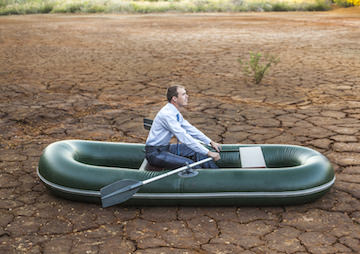California’s Water Supply Could Dry Up Within a Year
California's State Water Resources Control Board on Tuesday expanded emergency regulations regarding the state's use of water. Shutterstock
Shutterstock
California’s State Water Resources Control Board on Tuesday expanded emergency regulations regarding the state’s use of water.
The board announced the updated guidelines as news emerged that the combination of a four-year extreme drought and California’s high water use could hasten the end of the state’s remaining water supplies to within a year.
In addition to existing prohibitions against washing down sidewalks and driveways and using hoses without shut-off nozzles to wash cars, the expanded rules prohibit irrigating turf or ornamental landscapes during and 48 hours after measurable precipitation and serving water to restaurant customers unless they request it. The Los Angeles Times presaged Tuesday’s headlines with a sobering op-ed by Jay Famiglietti last Thursday:
Statewide, we’ve been dropping more than 12 million acre-feet of total water yearly since 2011. Roughly two-thirds of these losses are attributable to groundwater pumping for agricultural irrigation in the Central Valley. Farmers have little choice but to pump more groundwater during droughts, especially when their surface water allocations have been slashed 80% to 100%. But these pumping rates are excessive and unsustainable. Wells are running dry. In some areas of the Central Valley, the land is sinking by one foot or more per year.
As difficult as it may be to face, the simple fact is that California is running out of water — and the problem started before our current drought. NASA data reveal that total water storage in California has been in steady decline since at least 2002, when satellite-based monitoring began, although groundwater depletion has been going on since the early 20th century.
Right now the state has only about one year of water supply left in its reservoirs, and our strategic backup supply, groundwater, is rapidly disappearing. California has no contingency plan for a persistent drought like this one (let alone a 20-plus-year mega-drought), except, apparently, staying in emergency mode and praying for rain.
In short, we have no paddle to navigate this crisis.
Famiglietti also suggested what steps might be taken — by the government and the public — to head off disaster while there’s still time. “This crisis belongs to all of us,” he stressed, “not just to a handful of decision-makers.”
— Posted by Donald Kaufman.
Your support matters…Independent journalism is under threat and overshadowed by heavily funded mainstream media.
You can help level the playing field. Become a member.
Your tax-deductible contribution keeps us digging beneath the headlines to give you thought-provoking, investigative reporting and analysis that unearths what's really happening- without compromise.
Give today to support our courageous, independent journalists.






You need to be a supporter to comment.
There are currently no responses to this article.
Be the first to respond.